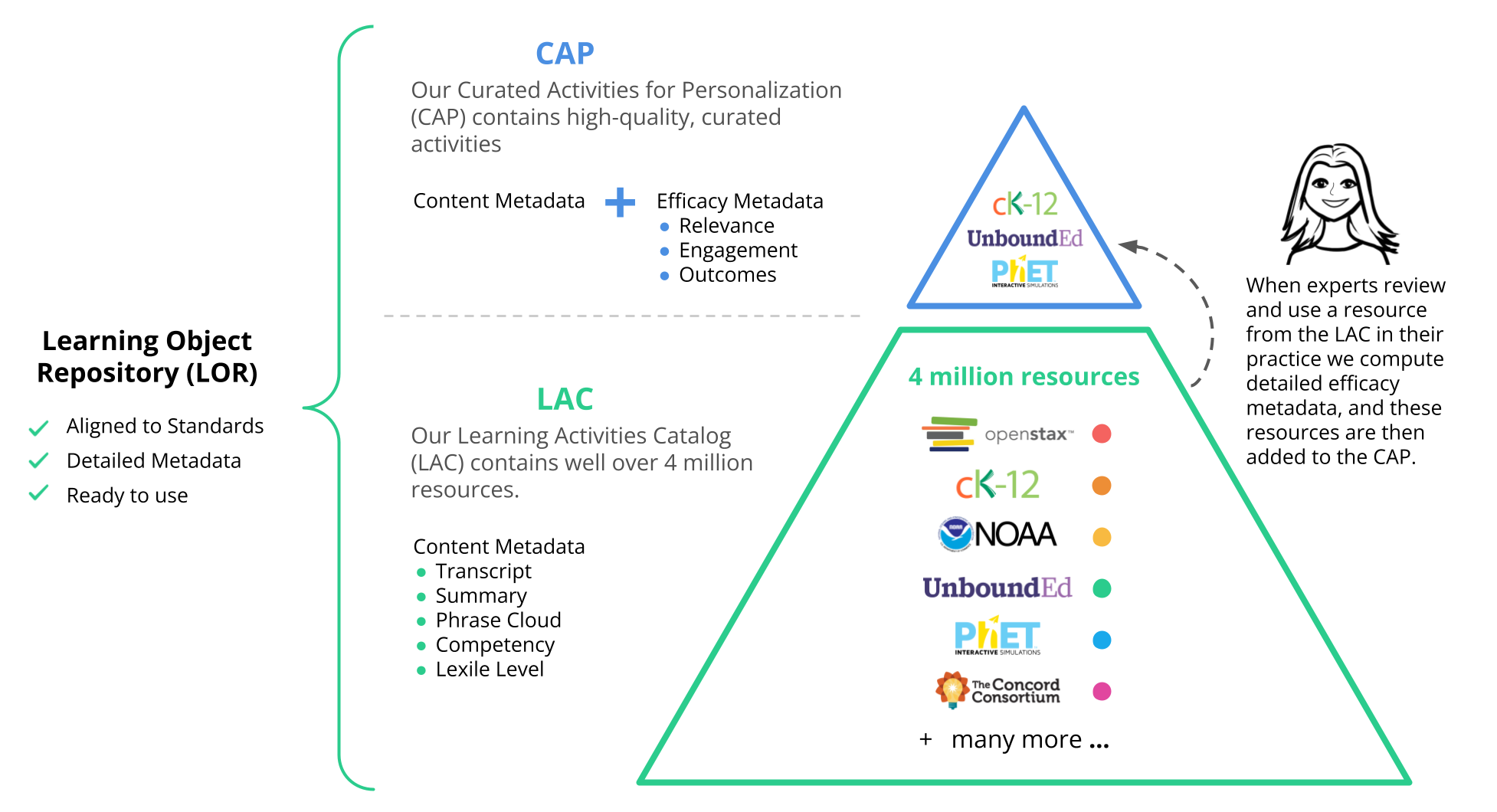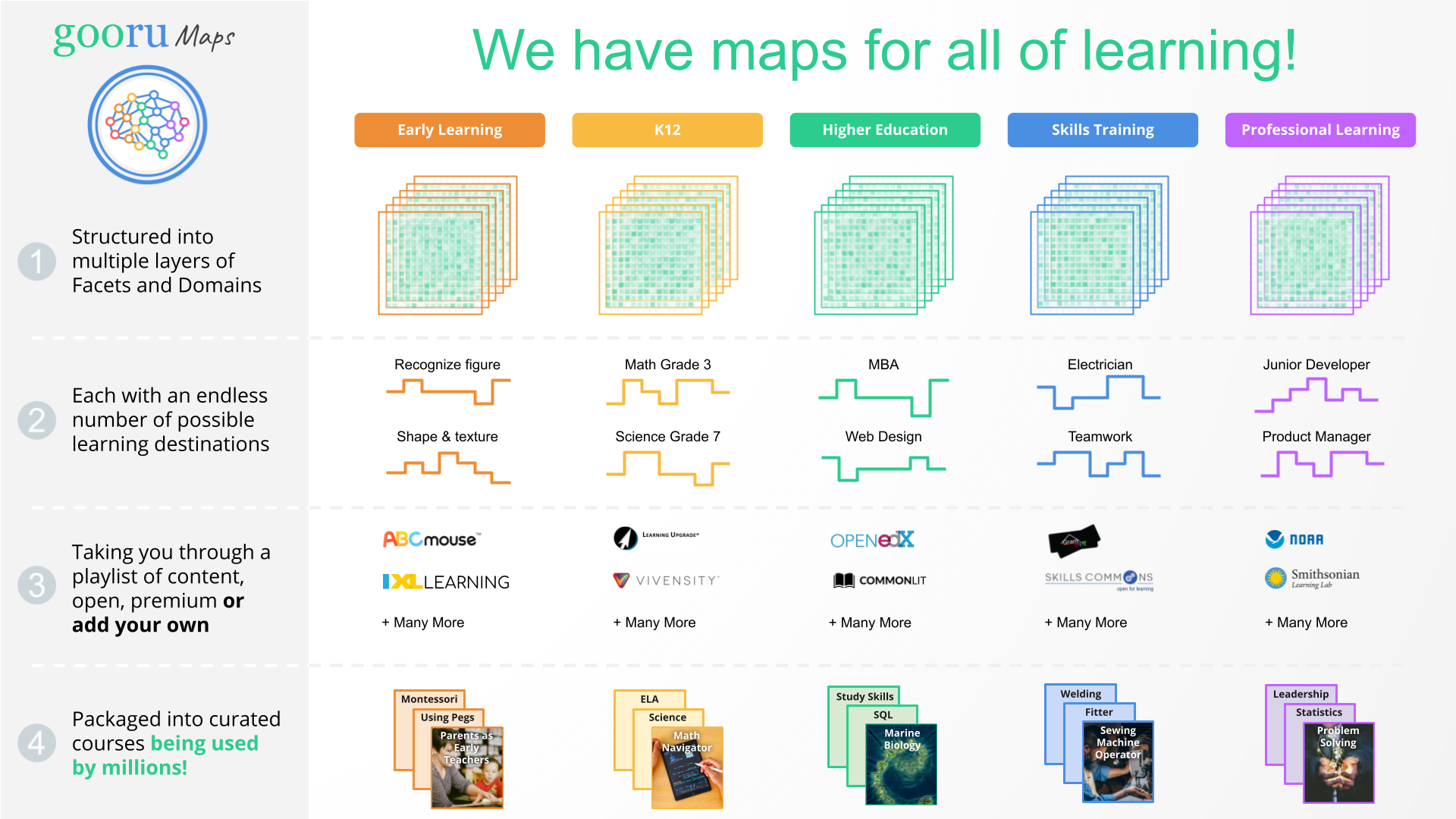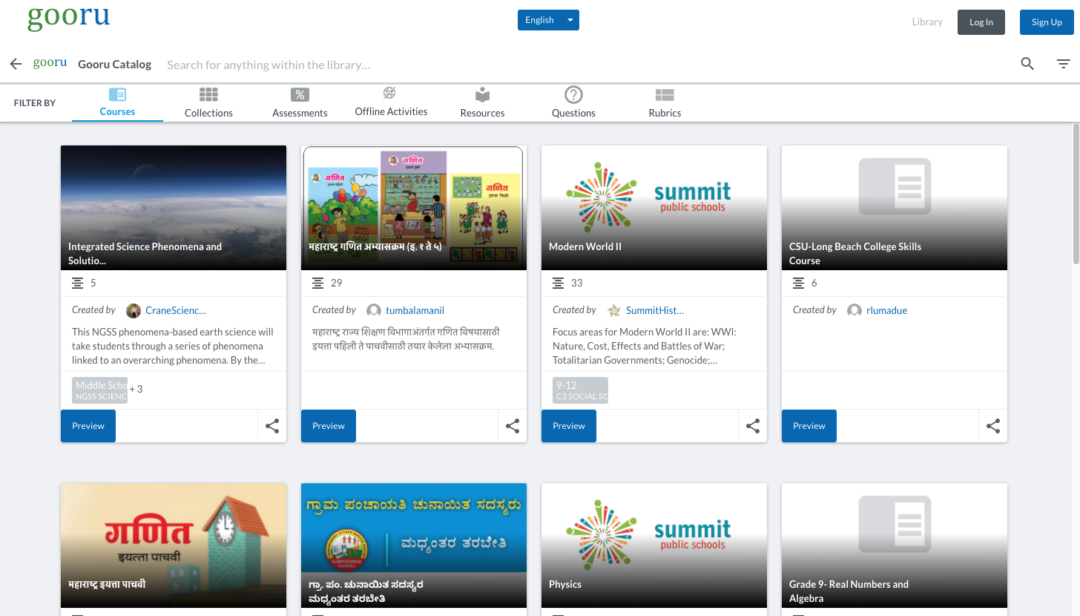Learning Object Repository
Gooru’s Learning Object Repository (LOR) contains more than 4 million resources that make up our Learning Activities Catalog (LAC). Those resources that have gone through the most extensive vetting are added to our Curated Activities for Personalization (CAP) catalog. The CAP contains thousands of high-quality, curated activities with comprehensive metadata tags that are standards-aligned and ready to use.
The LOR = LAC + CAP

Gooru has developed a Learning Activities Catalog (LAC) of millions of open resources from high-quality providers popular among users in relevant disciplines in specific geographies. The content in the LAC has been tagged with Metadata that includes; Transcript, Summary, Phrase Cloud, Competency, Lexile level, and more. Content that is consistently used by educators and is engaging and effective for teaching particular competencies graduates to be included in the Curated Activities for Personalization (CAP) and include additional metadata that includes; Relevance, Engagement, Outcomes, and more. Both the LAC and the CAP are commonly referred to in the industry as a Learning Objects Repository (LOR).
LOR Content for K-12
Catalog Distribution
0 Resources
Resource Types and Count
- Audio – 29,863
- Video – 74,585
- Interactive – 61,719
- Image – 80,935
- Webpage – 2,786,695
- Text – 239,754
0 Questions
Question Types and Count
- Multiple Choice – 159,681
- Multiple Answer – 888
- True Or False – 6,073
- Fill In The Blank – 10,280
- Multiple Select Image – 284
- Multiple Select Text – 436
- Highlight Text – 114
- Drag And Drop Order – 259
- Open Ended – 13,253
Distribution By Subject
0 Math Resources
- Assessments – 2,920
- Units – 196
- Questions – 47,705
- Resources – 124,620
- Lessons – 1,020
- Courses – 26
- Collections – 3,246
- Offline Activities – 145
0 Science Resources
- Assessments – 816
- Units – 112
- Questions – 78,491
- Resources – 2,264,872
- Lessons – 506
- Courses – 13
- Collections – 1,323
0 Social Sciences Resources
- Assessments – 290
- Units – 72,375
- Questions – 37,287
- Resources – 984,249
- Lessons – 541
- Collections – 593
0 English Language Arts Resources
- Assessments – 272
- Units – 307
- Questions – 10,084
- Resources – 154,023
- Lessons – 933
- Courses – 14
- Collections – 1,911
Distribution of Content in Non-English Languages
Language |
Resources |
Questions |
Collection |
Assessments |
Offline Activities |
| Hindi | 1,217 | 1,077 | 237 | 134 | 18 |
| Marathi | 1,708 | 1,354 | 247 | 251 | 197 |
| Dutch | 63,271 | 0 | 0 | 0 | 0 |
| Spanish | 80,699 | 0 | 0 | 0 | 0 |
CAP Content for K-12
Gooru has curated many thousands of high-quality K-12 content to be used when recommending personalized pathways within Navigator. These include:
- Digital resources such as websites, videos, interactive games, simulations, and text documents
- Questions are available in 9 different item types including drag and drop, true/false, open free response, multiple select, and multiple choice.
- Collections are curated sequences of resources and questions.
- Assessments are curated sequences of questions.
- Offline Activities like projects, seminars, presentations, group activities, and field trips.
- Team activities that support collaborative efforts
- Courses that are designed to facilitate personalized learning with Gooru’s Learning Navigator.
Subject |
Math 2-12 |
Science 6-8 |
ELA 5-8 |
CAP Totals |
| Total Competencies | 420 | 143 | 332 | 895 |
| Estimated Collections | 840 | 143 | 332 | 1,315 |
| Estimated Assessments | 1,320 | 143 | 332 | 1,795 |
| Estimated Resources | 2,520 | 575 | 996 | 4,091 |
| Estimated Questions | 5,280 | 715 | 1,660 | 7,655 |
| Estimated OAs | 380 | In Review | In Review | 380 |
| Estimated Solved Examples | 1,984 | In Review | In Review | 1,984 |
| Total Unique Content Articles* | 10,164 | 1,290 | 2,656 | 14,110 |
Example Activities
Gravitational Pull in the Solar System
Metadata
| Framework | Navigator Middle School Science |
| Subject | Middle School Science |
| Course | MS Earth and Space Sciences |
| Domain | Earth’s Place in the Universe |
| Competency Code | NMS.K12.NMS-SS-EU-06 |
| Competency Description | Develop and use models to describe the role of gravity in the movement and orientation of stars, planets, moons, asteroids, solar systems, and galaxies |
| Display Code | MS-ESS1-2.b |
| Description | Develop and use models to describe the role of gravity in the movement and orientation of stars, planets, moons, asteroids, solar systems, and galaxies. |
| Learning Objective | Develop and use models to describe the role of gravity in the movement and orientation of stars, planets, moons, asteroids, solar systems, and galaxies. |
| License | Public Domain (PDM 1.0) |
| ETL (secs) | 720 |
| Language | English |
| Audience | All Students |
| Publisher | Gooru Org |
| Thumbnail | https://cdn.gooru.org/aaa05420-7057-4475-9aea-8da33c58f6d3.jpg |
| Relevance | 0.78 |
| Engagement | 0.8 |
| Efficacy | 0.75 |
| Grade | 8 |
| Accessibility | CC |
| Access Hazard | None |
| Advertisement Level | No Advertisement |
| Frame breaker | FALSE |
| 21 Century Skills | Master Core Academic Content |
4.MD.7 Signature Assessment
Metadata
| Framework | Common Core State Standards |
| Subject | Math |
| Course | Grade 4 |
| Domain | Measurement & Data |
| Competency Code | CCSS.K12.MA-4-MD-C.03 |
| Competency Description | Recognize angle measure as additive. When an angle is decomposed into non-overlapping parts, the angle measure of the whole is the sum of the angle measures of the parts. Solve addition and subtraction problems to find unknown angles on a diagram in real world and mathematical problems, e.g., by using an equation with a symbol for the unknown angle measure. |
| Display Code | 4.MD.7 |
| Description | Recognize angle measure as additive. When an angle is decomposed into non-overlapping parts, the angle measure of the whole is the sum of the angle measures of the parts. Solve addition and subtraction problems to find unknown angles on a diagram in real world and mathematical problems, e.g., by using an equation with a symbol for the unknown angle measure. |
| Learning Objective | Recognize angle measure as additive. When an angle is decomposed into non-overlapping parts, the angle measure of the whole is the sum of the angle measures of the parts. Solve addition and subtraction problems to find unknown angles on a diagram in real world and mathematical problems, e.g., by using an equation with a symbol for the unknown angle measure. |
| License | Public Domain (PDM 1.0) |
| Language | English |
| Audience | All Students |
| DOK | Level 2: Skill/Concept,Level 3: Strategic Thinking |
| Publisher | Gooru Org |
| Thumbnail | https://cdn.gooru.org/78127c4c-5992-40dd-85ad-cd659ed5ed1c.png |
| Relevance | 0.84 |
| Engagement | 0.76 |
| Efficacy | 0.79 |
| Grade | 4 |
| Educational Use | Assessment |
| Access Hazard | None |
| Advertisement Level | No Advertisement |
| Frame breaker | FALSE |
| 21 Century Skills | Master Core Academic Content |
Modeling Asexual Reproduction in Bacteria
Metadata
| Framework | Navigator Middle School Science |
| Subject | Middle School Science |
| Course | MS Life Science |
| Domain | Heredity: Inheritance and Variation of Traits |
| Competency Code | NMS.K12.NMS-LS-HT-05 |
| Competency Description | Identify different forms of asexual reproduction and describe the number of parents, types of cells, organism type, and variation among offspring. |
| Display Code | MS-LS3-2.b |
| Description | In the last lesson, you modeled the process of sexual reproduction. But what about organisms like the cyanobacteria in blue-green algae that do asexual reproduction? In this activity, you will model asexual reproduction in bacteria. |
| Learning Objective | In the last lesson, you modeled the process of sexual reproduction. But what about organisms like the cyanobacteria in blue-green algae that do asexual reproduction? In this activity, you will model asexual reproduction in bacteria. |
| License | Public Domain (PDM 1.0) |
| ETL (secs) | 3000 |
| Language | English |
| Audience | All Students |
| DOK | Level 2: Skill/Concept |
| Publisher | Gooru Org |
| Thumbnail | https://cdn.gooru.org/4ad4c509-a4eb-4a7b-8997-917c2333897d.jpg |
| Relevance | 0.75 |
| Engagement | 0.81 |
| Efficacy | 0.79 |
| Educational Use | Project |
| Access Hazard | None |
| Advertisement Level | No Advertisement |
| Frame breaker | FALSE |
| 21 Century Skills | Master Core Academic Content |
PhET Fraction Matcher
Metadata
| Framework | Common Core State Standards |
| Subject | Math |
| Course | Grade 3 |
| Domain | Number & Operations–Fractions |
| Competency Code | CCSS.K12.MA-3-NF-A.03.02 |
| Competency Description | Recognize and generate simple equivalent fractions, e.g., 1/2 = 2/4, 4/6 = 2/3). Explain why the fractions are equivalent, e.g., by using a visual fraction model. |
| Display Code | 3.NF.3.b |
| Description | Match shapes and numbers to earn stars in this fractions game. Challenge yourself on any level you like. Try to collect lots of stars! |
| Language | English |
| Quality Indicator (Editorial tag) |
5 |
| Copyright Owner | PhET |
| Thumbnail | https://cdn.gooru.org/f000/2473/1436/96b67140-4044-11e4-9966-7bbb2c1dced5_b0e95275-97df-432b-b9eb-ad0691638a20.png |
| Relevance | 0.91 |
| Engagement | 0.92 |
| Efficacy | 0.89 |
| Grade | 3 |
| Educational Use | Activity |
| Access Hazard | None |
| Advertisement Level | No Advertisement |
| Frame breaker | FALSE |
| Summary | No summary is generated for interactive resources |
| Transcript | No transcripts are generated for Interactive resources |
Question 4
Metadata
| Framework | Navigator Middle School Science |
| Subject | Middle School Science |
| Course | Integrated Middle School Science |
| Domain | From Molecules to Organisms: Structures and Processes |
| Competency Code | NMS.K12.NMS-LS-FP-05 |
| Competency Description | Describe the structure and function of the cell wall, particulary its protective and structural roles in plant cells. |
| Display Code | MS-LS1-2.c |
| Description | Describe the structure and function of the cell wall, particularly its protective and structural roles in plant cells. |
| Learning Objective | Describe the structure and function of the cell wall, particularly its protective and structural roles in plant cells. |
| License | Public Domain (PDM 1.0) |
| ETL (secs) | 120 |
| Language | English |
| Audience | All Students |
| DOK | Level 2: Skill/Concept |
| Publisher | Gooru Org |
| Grade | 6 |
| Media Features | Image |
| Access Hazard | None |
| Advertisement Level | No Advertisement |
| Frame breaker | FALSE |
Math Navigator (Integrated Pathway)
Metadata
| Framework | CCSS Integrated Math |
| Subject | Math |
| Course | Integrated Math (Grade K – HS) |
| Display Code | INTM.K12.MA |
| License | Public Domain (PDM 1.0) |
| Language | English |
| Audience | All Students |
| Publisher | Gooru Org |
| Thumbnail | https://cdn.gooru.org/db88085a-78da-49d8-a925-c413f93d15ae.png |
| Relevance | 0.93 |
| Engagement | 0.89 |
| Efficacy | 0.9 |
| Educational Use | Course |
Activity Types
Gooru has developed multiple tools that provide access to our Learning Object Repository (LOR), which includes millions of multimedia web resources, thousands of educator curated collections and assessments, and over fifty classroom-ready courses that are aligned to national standards.
US Standards Coverage
National Frameworks
- CCSS (Math, ELA)
- NGSS (Science)
- C3 (Social Science)
- CSTA K-12 Computer Science Standards
State Frameworks
Alabama, Arizona, California, Colorado, Connecticut, Delaware, District of Columbia, Florida, Georgia, Hawaii, Idaho, Illinois, Kansas, Kentucky, Louisiana, Maine, Maryland, Massachusetts, Michigan, Minnesota, Mississippi, Montana, Nevada, New Hampshire, New Jersey, New Mexico, New York, North Carolina, Ohio, Oklahoma, Pennsylvania, Rhode Island, South Carolina, South Dakota, Texas, Utah, Vermont, Virginia, Washington, Wisconsin
How Navigator is being used
Gooru Maps

Gooru Metadata Schema
Resources are reviewed at the “domain” level for many metadata fields, including editorial tags. In order to capture and communicate each resource’s relevance for partners and teachers across the globe, we developed the Gooru Metadata Schema, a comprehensive structure that determines how content will appear and be discoverable in the Gooru platform and via APIs.
| Meta Data Field Title | Description | Example(s) |
| URL | The URL of the resource. | interactives.ck12.org |
| License & License Code | The type of license specified for using the resource.
For more information about Creative Commons licenses, visit the Creative Commons website. |
Attribution-NonCommercial-ShareAlike 1.0 Generic CC BY-NC-SA 1.0 |
| Name | The title of the resource (limit: 50 characters). | Observation of Cells |
| Audience | The audience for which the resource is intended–student or teacher. | Student |
| About | The description of the resource (limit: 300 characters). | This video provides an introduction and overview of cells and cell function. |
| Language | The language of the resource. For videos, it is the language of the dialogue. | English |
| Publisher | The organization credited with publishing the resource. | MIT OpenCourseWare |
| Resource Format | A “resource,” as used in Gooru, is any online-based web material that can be used for instructing or studying K-12 curriculum:
|
Click the resource formats in the left column for exemplars |
| Subject | The subject area that is aligned with the resource’s content. | Math |
| Thumbnail | The URL of the resource thumbnail. | http://www.in.gov/judiciary/citc/images/icivics_logo.jpg |
| Grade Level | The intended grade level of the material.
Gooru supports the following grade levels: Pre-K, Kindergarten, 1, 2, 3, 4, 5, 6, 7, 8, 9, 10, 11, 12, Higher Education |
1,2,3,4 |
| Depth of Knowledge | The categorization of content based on Webb’s Depth of Knowledge including:
Note: This field only applies to question resources. |
Level 1: Recall Level 2: Skill/Concept Level 3: Strategic Thinking Level 4: Extended Thinking |
| Standards | The type of educational standards used for alignment.
Gooru currently supports the following standards frameworks:
State frameworks supported
|
Common Core State Standards |
| 21st Century Skills | The 21st Century Skills are the categorization of content based on Conley Four Keys, Hewlett Deeper Learning Model, P21’s Framework for 21st Century Learning, and the National Resource Center for Life and Work.
21st Century Skills include: Key Cognitive Skills and Strategies
Key Content Knowledge
Key Learning Skills and Techniques
|
Problem Formulation, Civic Literacy, Creativity, Collaborative Learning |
| Ads | Identify the presence of ads on the resource.
|
Moderate Advertisement |
| HTTPS/HTTP | Indicates if a domain is https/http so it can be embedded in corresponding environments | |
| Cannot iFrame | A resource that cannot be displayed in the Gooru player due to ‘X-Frame-Options’ settings. | Example |
| Breaks iFrame | A resource that opens in the native site rather than within the Gooru player. This resource immediately redirects the entire player page to the resource site. | Example |
Detailed Information
For further detailed information on our LOR, LAC, and CAP we have created this comprehensive document.
Competency Frameworks Mapped
Gooru and the collaborator community have the ambitious goal of mapping out all of human knowledge and making it openly available for anyone to use.
0 Content in our CAP
0 Content in LOR
0 Competencies
Explore how content developers are adding content to Gooru Library
Explore Some Content
Explore Gooru Navigator as a Teacher or Student to view some of this content
